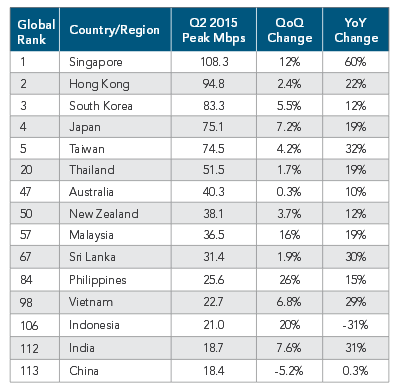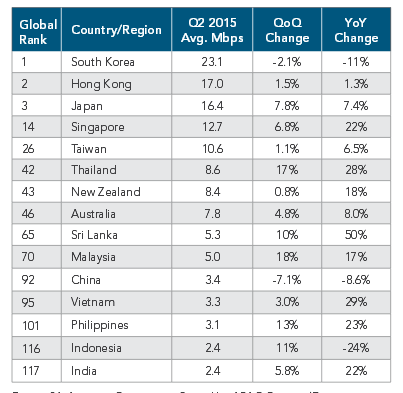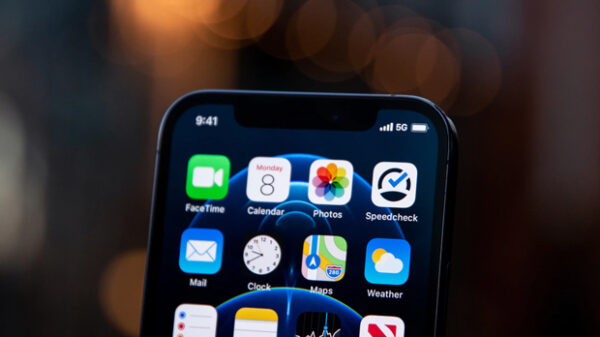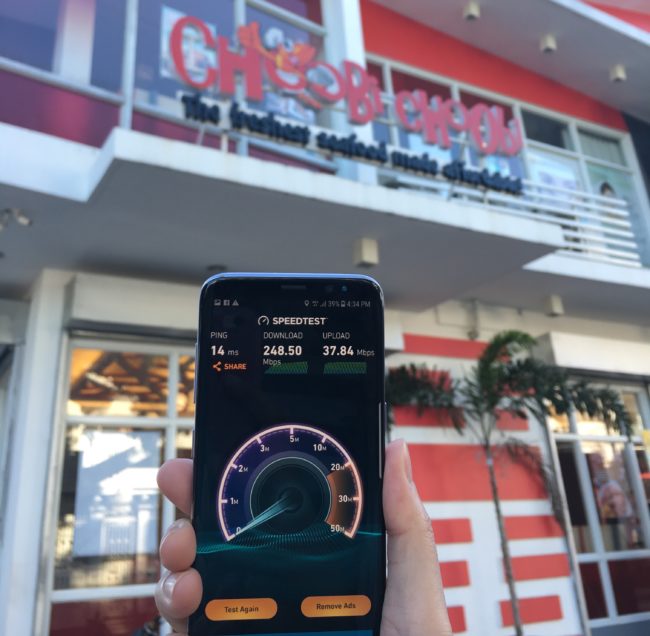While the Philippines posted an increase in its average Internet connection speed in the second quarter of 2015, it is still below the global average.
Ranked 101st globally and 13th in Asia Pacific in terms of Internet connection speed, the Philippines posted an average connection speed of 3.1Mbps in the second quarter of 2015, a 13% increase quarter-on-quarter and 23% year-on-year, according to Akamai Technologies, Inc.’s “State of the Internet” Report. Meanwhile, the country’s average peak connection speed is at 25.6Mbps.
The Akamai report surveyed 145 countries globally. Fifteen of the countries came from Asia Pacific.
Globally, average connection speed increased 3.5% to 5.1 Mbps in the second quarter of 2015. Quarterly changes were positive for the top 10 countries/regions, with the exception of South Korea (23.1 Mbps), which decreased 2.1% from the first quarter.
Japan (16.4 Mbps) saw the largest quarterly gain at 7.8%, while the remaining eight countries experienced modest gains ranging from 1.5% in Hong Kong (17.0 Mbps) to 4.6% in Switzerland (15.6 Mbps).
Average connection speeds among the top 10 countries/regions all remained well above 10 Mbps and like the previous quarter, six of the 10 had average connection speeds above 15 Mbps.
Globally, 110 out of 144 qualifying countries/regions saw average connection speeds increase from the previous quarter, with growth rates ranging from a modest 0.4% in Senegal (1.5 Mbps) to a substantial 67% in Tunisia (2.8 Mbps).
Like last quarter, year-over-year changes were consistently positive in the top 10, except for South Korea, which declined 11% compared with the second quarter of 2014. On a global basis, the average connection speed increased 17% year over year.
In the second quarter, global average peak connection speeds increased 12% to 32.5 Mbps. Speeds increased in every top 10 country/region except Sweden (62.8 Mbps), which remained unchanged from the first quarter. Singapore (108.3 Mbps) saw the only double-digit quarterly gain, with a 12% increase, while the remaining eight countries saw increases ranging from 0.6% in Romania (72.1 Mbps) to 7.8% in Macao (62.6 Mbps).
Eight of the top 10 saw average peak speeds greater than 70 Mbps, while Sweden and Macao saw speeds above 60 Mbps. On a global basis, 107 of the 143 qualifying countries/regions saw average peak connection speeds increase from the first quarter, with growth ranging from 0.1% in Trinidad and Tobago (34.9 Mbps) to 100% in Egypt (23.4 Mbps).
Year-over-year all of the top 10 countries/regions saw increases in average peak connection speeds except Israel (71.4 Mbps), which posted a 14% decline. Last quarter, the State of the Internet reported for the first time on the percentage of IP addresses connecting to Akamai at average speeds of above 25 Mbps, the new benchmark broadband speed adopted by the U.S. Federal Communications Commission in January 2015. Globally, 4.9% of unique IP addresses connected to Akamai at average speeds of at least 25 Mbps, a 7.5% increase over the previous quarter.
Despite a 5.5% quarterly decline to a rate of 29%, South Korea again led the world in 25 Mbps broadband adoption, just as it has for all of the other broadband adoption metrics in the second quarter. Its adoption rate was nearly double that of second-place Hong Kong, which dropped 2.9% from the first quarter to 16%.
Year-over-year, global 25 Mbps adoption dropped slightly, by 0.5%, in contrast to the 20% yearly growth seen in the first quarter. Two of the top 10 countries saw losses: South Korea’s adoption rate dropped 24% and Hong Kong’s declined 11%. In the United States, five states had 10% or more of unique IP addresses connect to Akamai at average speeds of at least 25 Mbps.














































































































